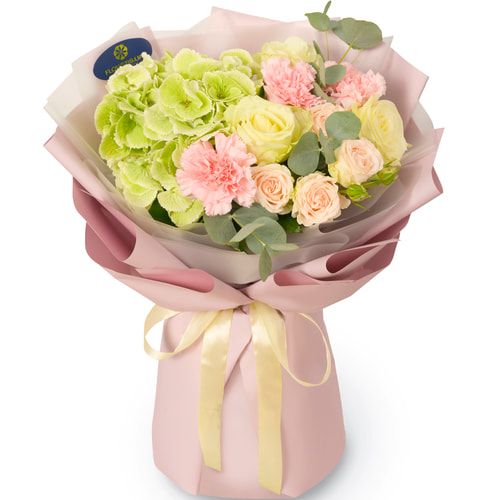Indoor Ivy (Hedera): Care and Cultivation at Home
Indoor ivy (lat. "Hedera") is a very popular plant, the first mention of which dates back to the times of Ancient Greece. In earlier days, there was a tradition to make wreaths of ivy for girls as a holiday decoration. It was also believed that Hedera scares away the evil spirits and brings good luck. Today, the ivy is especially appreciated by designers as a universal plant for ‘greening up’ a room. Florists often use ivy in compositions along with pelargonium and other indoor plants. In our catalog, there are many options that will interest the fans of domestic plants, as well as a wide range of seasonal flowers in Zaporizhzhia.
Types of Hedera
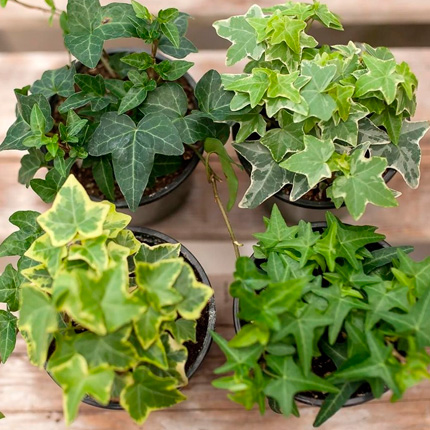
This vine grows naturally in dense, shady forests, covering a fairly large space. In countries with a temperate or subtropical climate, the ivy often spreads over large areas, wrapping around buildings and other places. However, it has gained real popularity as an ornamental houseplant. The ivy makes a great addition to large spaces and is great for vertical gardening. Hedera has about 15 species, and we will look at the most popular ones in this article.
Canary Ivy
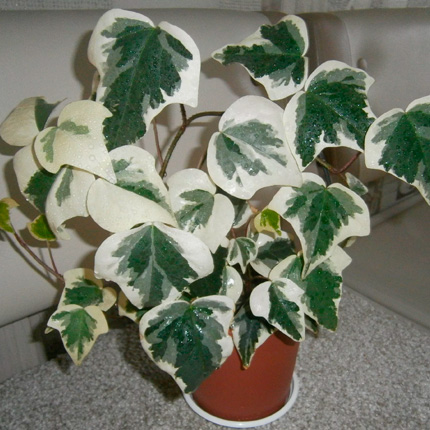
Canary ivy is an evergreen vine, which was named after its habitat. It grows in coastal parts of Portugal, Morocco, and North Africa. Its leaves are deep green with large white spots. This species spreads beautifully along the ground, forming bizarre patterns, but also easily climbs up, and if there is a support, it wraps its branches around it. Canary ivy does not have aerial roots, so regular pruning is necessary to ensure that the support is strong. The known varieties are Brigitta, Golden Leaf, Striata, and Gloire de Marengo. Like many other office plants, Canary ivy is unpretentious, but requires regular spraying.
Hedera Colchica
This creeping vine comes from Transcaucasia and Iran. It easily climbs to a height of 30 m (~98 ft.). The aerial roots and powerful stems provide it with reliable stability. The large Hedera Colchica leaves have a pleasant smell with hints of nutmeg. The vine blooms in autumn; the flowers smell unpleasant and form umbrella inflorescences. If you grow this ivy at home, make sure that the soil is as fertile as possible.
Hedera Pastuchovii
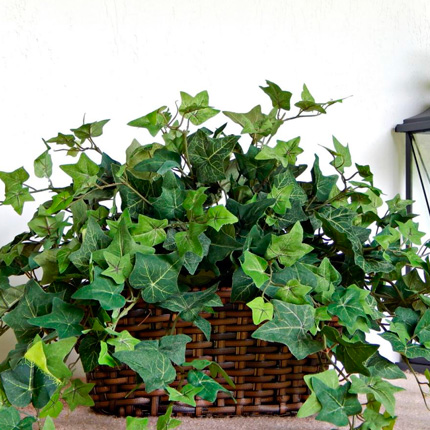
An evergreen vine from the Araliaceae family, which grows in Georgia, Russia, and Azerbaijan. An indispensable plant in vertical decoration due to its aerial roots and beautiful appearance, it is considered an endangered species and is listed in the Red Book. The inflorescences are collected in umbrellas, the leaves are rounded, and at the top there are rhombic, ovoid, and mixed types of foliage.
Ivy
The most popular type with a high decorative value. Ivy is typically used to decorate facades and arbors in Europe, arbors and fences in Asia and Eastern Europe, but it is mainly utilized as a houseplant. Ivy successfully masks the flaws of a house, emits a lot of oxygen, and is completely unpretentious in care. The leaves are leathery, arranged alternately, and soft to the touch. The flowers are collected in small umbrella inflorescences; the fruits are small and poisonous to humans, but serve as good food for many birds.
Hoya (Wax) Ivy
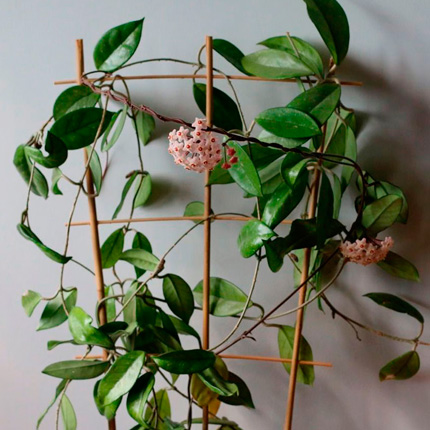
A beautiful evergreen vine that is very easy to grow at home. The name of the plant was given by the botanist Robert Brown, in honor of his friend, Thomas Hoy. At home, this ivy grows no more than 6 m (~19.7 ft.) in length. With the appearance of aerial roots, the shoots become woody and grow fleshy leaf plates with gray patches. The shape of the flowers is very different, but they are united by the presence of 5 petals. A new flower immediately begins to grow in place of the old one after withering. The blooming begins in May and ends in early autumn. Hoya perfectly coexists with other plants, is harmless to humans, and its flowers have a pleasant smell. The shape of the flowers resembles small stars, and they are collected in hemispheres.
Fatshedera Lizei (Tree Ivy)
A hybrid that was obtained by crossing the Fatsia plant and Hedera. The leaves reach 25 cm (~9.8 in.) in length, with white spots on the plate. Despite the fact that growing this species is quite simple, in practice even experienced florists can face difficulties. Fatshedera is a very flexible plant and easy to form, but often it does not start to bush, no matter what you do. This may be due to improper watering, substrate type, or poor lighting. The tree ivy is hugely popular in design because of its showy appearance and good upward growth. If you take care of it correctly, the plant will delight you with its looks for many years and provide a large amount of oxygen.
Indoor Ivy Care

The ivy does not need too much care if you follow the simple rules. Keep track of the plant’s location and proper feeding; cut off the excess shoots in time and prevent the Hedera pests and diseases from spreading.
Location
First of all, you need to decide where your ivy will stay. The most important thing to remember is that the ivy belongs to a small category of shade-loving plants, so the bright light is harmful for it. You can safely place the ivy in the back of the room, or even in the corridor. Make sure that it receives diffused light during the day. In winter, the daylight hours are reduced, so if you have a variegated representative of the species, you can think about the temporary artificial lighting. When intending to grow ivy as an ampel plant, it makes sense to place it against a wall and give room for young shoots. You should not change the location of the ivy, as the plant can have adjustment issues, so consider the prospects for growth, placement, and lighting in advance.
Temperature
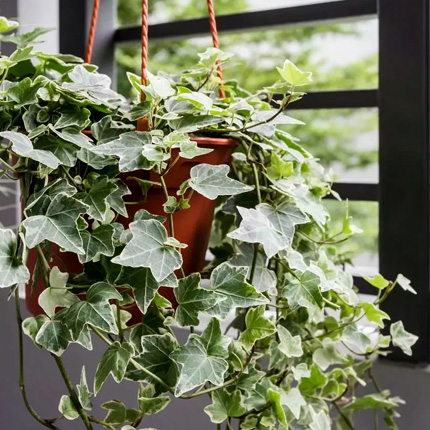
The temperature is an important factor for the proper growth of indoor ivy. The ideal one is 18-22°C (64.4-71.6°F). In hot and dry weather, the leaves must be constantly sprayed so that the ivy does not dry out. Don’t forget to dust it off to prevent spider mites. In winter, a comfortable temperature is considered to be 11-14°C (51.8-57.2°F). It is strictly prohibited to keep the ivy near heating appliances. If the room has a heater, try to water the ivy more often or use a humidifier. Sharp fluctuations in temperature and draughts will not cause significant harm to Hedera, but try to avoid them in any case.
Soil and Watering
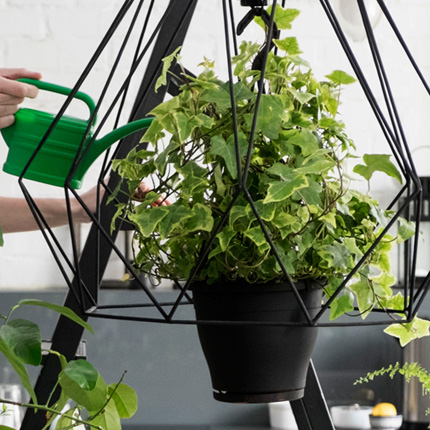
The vine grows well in almost any soil, but prefers a slightly acidic substrate with a lot of humus. The soil should remain slightly damp inside in winter, and in summer, the ivy will require more water. The watering should be done twice a week in summer and once a week in winter, considering the temperature. For instance, if the temperature is stable around 22°C (71.6°F), the frequency of watering can be increased. Although the ivy is difficult to overfill with water, there is a constant risk of insufficient watering. Complex fertilizers once a month in winter and two or three times in the warm season will definitely help the plant. The ivy responds to special and peat fertilizers best of all; the leaves may begin to turn yellow and crumble with an excess of moisture or top dressing. It is important to fertilize a few hours after the principal watering, so that the vine has time to absorb all the nutrients. The ivy is quite capable of spending some time without water, but you should not abuse this property. During the “drought”, the leaves may begin to curl, and the shrub will lose a lot in terms of attractiveness.
Pruning and Support
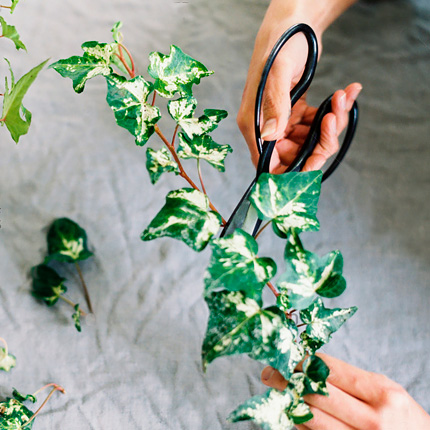
Be sure to prune Hedera at least periodically to get the right shape, direct the growth where you need it, and refresh the plant. To create a magnificent form, leave only a few buds for the young shoots to break through from at a later time. The sick and dried branches must be removed as well; otherwise they may destroy the entire plant. Pruning also saturates the plant with oxygen. Hedera has very flexible and durable shoots that do not allow the vine to break under its weight. A pot of ivy is often hung on the wall, and its branches decorate the room, provide oxygen, and hang beautifully. The soil for the ivy is often mulched; it is better to use humus or fallen leaves for the plant’s health.
The Special Mixture
Each flower grower decides for themselves what kind of soil mixture to choose for the vine. The heated debate about the optimal substrate continues to this day, but most tend to make their own soil. Combine peat, leaf, and turf mixture in equal proportions. If the resulting soil is too heavy for a young plant, add some sand. The most important thing is that the substrate should be light enough and pass the necessary oxygen well.
Transplanting the Ivy
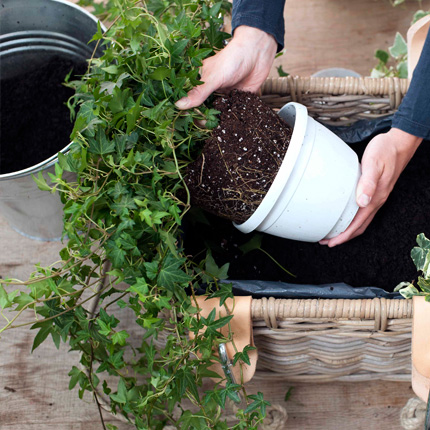
The vine is transplanted as its roots grow. For a young plant, the pot is changed once a year, then once every two years. As a rule, only young plants are transplanted; the mature ones that have taken root should not be touched too much. It is best to transplant the ivy in the spring, along with a clod of earth, so that the plant quickly gets accustomed to the new place. For mature plants, it will be enough to simply refresh the top layer of the substrate. The ivy care is generally similar to Guzmania care, with the only difference being that the vine is ready to forgive some mistakes on your part, unlike the perennial from Latin America.
Propagation Methods for Indoor Ivy
In an ordinary house, the ivy can be propagated by cuttings, shoots, and layering, which is best done in May or June. If the cutting was purchased from a nursery, it is best not to transplant it for 1-2 weeks, for it to get used to the new conditions in the familiar ground.
Propagation by Cuttings
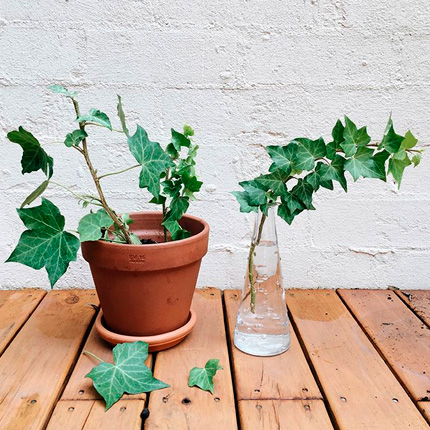
In a mature plant, it is necessary to take the cuttings from the top. Plant them in plain water first until they take root, and then transplant them into pots with the all-purpose mix to encourage growth. It is better to choose rich soil for increasing the chances of success. If you water the ivy moderately and observe all the conditions (shade, temperature, humidity), the first sprouts will not take long to appear. No more than 3 cuttings are planted in one pot so that they are not pressed for space. The ivy can be rooted in water, in a special mixture with the addition of peat, or in a light substrate with a high sand content. Both tip and stem cuttings are good choices.
The ivy breeds well in a greenhouse or even a container. The shelter for the young ivy is not at all necessary, but it certainly does not do any damage. Plastic film or glass accelerates growth and helps the ivy to take root. If you urgently need to get a mature plant, you can use growth stimulants, but this should be approached with caution. The entire rooting process takes 2 to 6 weeks. Stem cuttings are placed in a pot in a horizontal position, and leaves are left on the surface for shelter. The rooting of the stem cutting is much faster and takes a period of 1 to 2 weeks. After the first signs of growth, carefully remove the stem from the pot and take individual cuttings. The rooted cuttings are rarely transferred to a permanent place immediately and are typically sent to the garden for growing. The ivy is usually planted permanently in late summer or early autumn. Nonetheless, remember that if you decide not to wait until spring, the plant needs to be protected and the soil around it should be well mulched.
Propagation by Layering
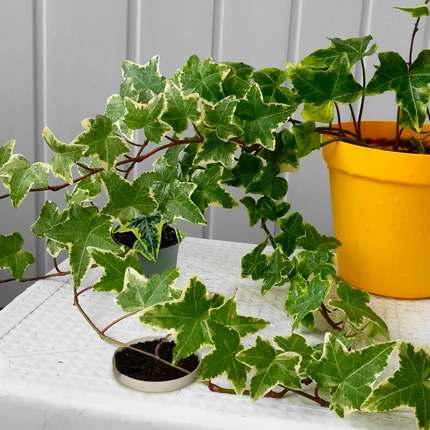
Like most other representatives of their species, Hederas easily reproduce by layering. The scourges on the ground are able to take root on their own, but nothing bad will happen if you give them some help. The ivy is usually propagated by layering by those who use the vine as a ground cover. This method is also convenient if you do not need a large amount of ivy in your garden or greenhouse. The strongest and most flexible shoots are placed in a trench or other shallow hole. It is necessary to make several small incisions for stimulation, fasten the branches with staples, and sprinkle everything with a nutrient substrate or peat humus. For the first time, it is necessary to water the layers abundantly to stimulate growth – and in the future not to leave the vine without watering; as we already know, the more water, the better. If the ivy has long branches, then it is best to fix them in waves and root several layerings at once. Naturally, this method is more suitable for those who have their own mini-garden, as the simpler cutting method is typically used for propagation. Choose the young one-year-old, maximum two-year-old plants for rooting and propagation by layering. Immediately reject strong shoots with aerial roots or shoots that are almost stiff.
Propagation by Shoots
A rare but fairly simple way to propagate the ivy, this process is very similar to propagation by layering. For a start, cut off a shoot about 10 cm (~4 in.) long together with the leaves. Make a small incision and gently press the shoot into the soil in the pot. After a short period of time, the roots will begin to appear along the entire length of the shoot. It can be cut into several parts as the next step, with each cutting having a root and a leaf. The resulting material is planted in a separate pot with a nutrient substrate.
Useful Properties

The indoor Hedera is a hardy and unpretentious plant that is widely used in folk and traditional medicine. The main active ingredients in the composition of the plant are saponins and flavonoids. Saponins improve the body’s absorption of nutrients, specifically in the intestines. Flavonoids, on the contrary, help to get rid of harmful and heavy substances, and have an additional tonic effect. They also strengthen the cardiovascular system, produce a considerable amount of beneficial enzymes, and block mast cells. Furthermore, Hedera leaves contain coumarins, gum, tannins, essential oils, fructose, vitamins, and other compounds.
Due to their rich chemical composition, ivy leaves are used as anti-inflammatory, antimicrobial, antitumor means and, especially, as an expectorant. The use of ivy is recommended during bronchitis, asthma, pneumonia, and other respiratory diseases. The ivy thins the phlegm and generally makes breathing easier. The first mention of ivy as a medicine is found in the writings of the Celtic Druids; now the most widely used extract is from its leaves. It is a good remedy for congestion in the bronchi and asthma. The ivy teas can also be used as a lighter option for children.
Ivy decoctions are recommended for the skin and urinary tract diseases, arthritis, and kidney issues. Hedera also does an excellent job with calluses and corns. A paste from the crushed fresh leaves on a napkin should be applied to the affected area, and then dressed with a bandage or polyethylene. Change it every 2-3 hours, and after a few days you will notice an improvement. Keep in mind that the ivy is not recommended for children and pregnant women. In case of an ivy component overdose, allergies, rashes, and itching all over the body can begin. It is best to avoid using the preparations from the ivy for longer than 1 week.
The ivy is a proven hair care product in cosmetology. Rinsing the hair with ivy decoction helps to quickly get rid of dandruff, strengthen hair follicles, and improve hair growth. A decoction is prepared from 100 g of crushed ivy leaves and a glass of boiling water, which is infused for about half an hour. You need to rub in the resulting broth immediately after washing your hair for 7 days. The positive effect of such a decoction in battling skin diseases has long been noted. It has a tonic effect on the facial skin, removes bags under the eyes, blackheads, and acne, while also helping with skin dryness. Some people put the decoction in the freezer and make special cubes out of it for rubbing the affected skin areas.
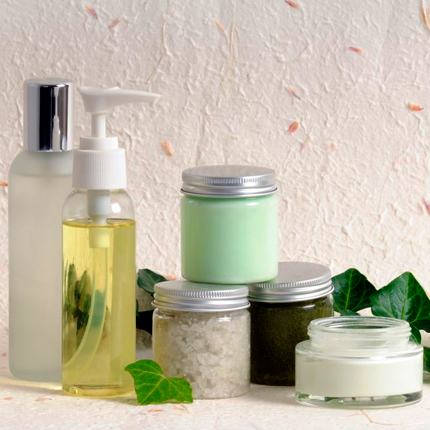
A special ointment is popular for cellulite treatment in folk medicine. It is not at all difficult to make at home; you only need to mix the crushed leaves, ivy juice, and honey in equal proportions, and rub it into the body during a shower or after a bath. As a result, blood circulation improves while toxins and other harmful substances are removed. The ivy is considered useful in battling wrinkles; the extract from this plant improves skin elasticity and eliminates age spots.
Diseases and Pests
The most common ivy disease is falling leaves. As a rule, this happens due to the wrong temperature conditions. The comfortable temperature for the ivy ranges from 18 to 22°C (64.4-71.6°F), and its excess can lead to drying. In the summer and late spring, it is necessary to regularly spray the plant; water well, but do not flood it, though. The other reason for this issue may lie in the spider mite infestation.
If your ivy loses leaves, this is not yet a reason to panic. A mature plant may be shedding the extra foliage, so it may be worth performing simple pruning. The ivy is considered a shade-loving plant; however, lack of sunlight can lead to unwanted consequences. Before repotting the plant or changing the substrate, try giving your Hedera more sun first. If the leaves have lost their bright color, it is possible that the pot has simply become too small for the ivy. This problem is especially relevant in case of young plants. Insufficient care or watering, wrong temperature conditions can easily promote pests.
Some of the most dangerous enemies of the ivy are:
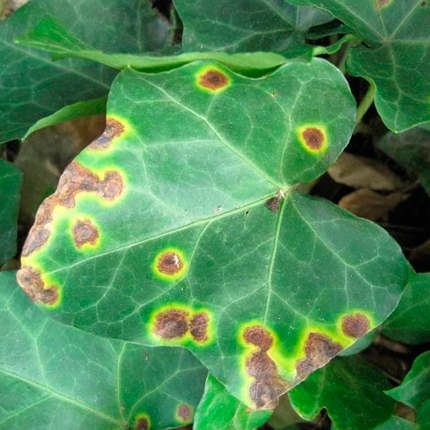
- Spider mite. It spreads at lightning speed, but traces of the lesion are visible even with a superficial examination. The ivy seems to be wrapped in cobwebs, and the shoots and leaves look unhealthy. The issue is solved by spraying the plant with special insecticides or by “showering” it. The spider mite is the most dangerous pest for the ivy, able to completely destroy it in just 2 weeks.
- Scab. These pests love most indoor plants, and the ivy is no exception. They are visible to the naked eye on the leaves. The parasites make them sticky and unpleasant to the touch, also sucking the juices and vitality out of Hedera The easiest and safest way to get rid of them is to spray the ivy with soapy solution or the <i>Carbofos</i> insecticide.
- Aphid. It resides on the leaves in whole colonies, and if nothing is done, sooner or later kills the plant. Aphid reproduces exponentially, making the ivy sluggish and the leaves, yellow. To solve the problem, it is necessary to carefully treat each leaf with insecticides and place it under polyethylene, spraying it with warm settled water afterwards.
- Thrips. The parasite settles on the bottom of the leaves. It is easy to notice it, as the leaves become stained on both sides. It reproduces very quickly and begins to lay eggs. You can only fight it with insecticides, and before processing, it is advisable to make a warm shower for the ivy.
- Mealybug is the third most common pest of houseplants after spider mites and aphids. It clogs the leaves with sticky slurry and attaches to them, eating useful substances. It is especially dangerous because it feeds on the juices of young shoots and does not allow the ivy to grow normally. Before processing the plant with special solutions ("Aktara", "Carbofos", "Aktellik"), you need to collect the worm with gloved hands and spray the leaves with soapy water in a ratio of 1:6.
The best way to battle the ivy’s pests and diseases is prevention. If you take proper care of the plant, the pests will not threaten it. Hedera care is quite simple, so you should not wait until the onset of dangerous diseases.
